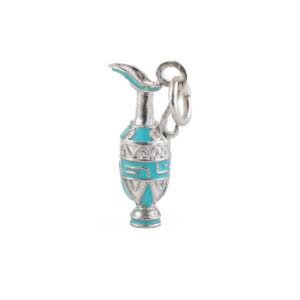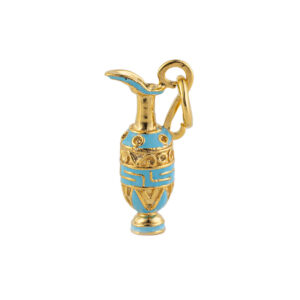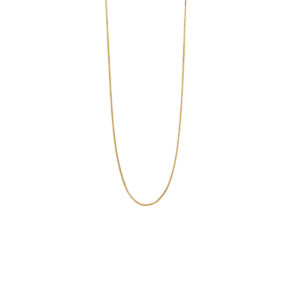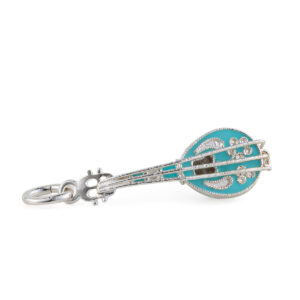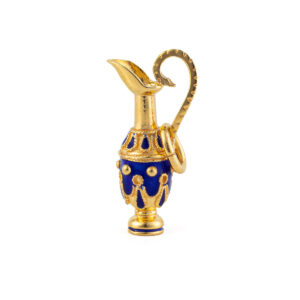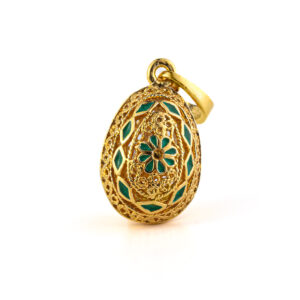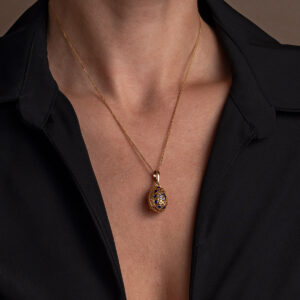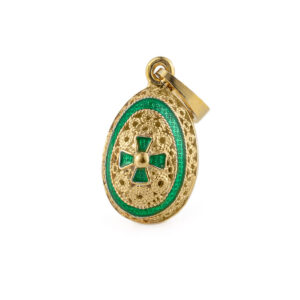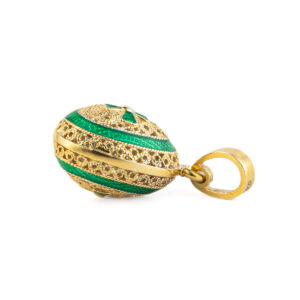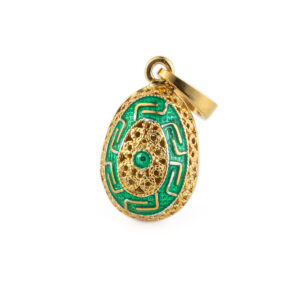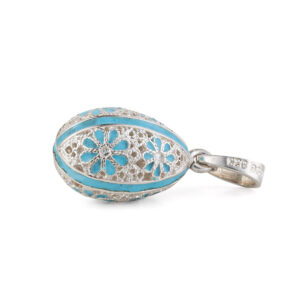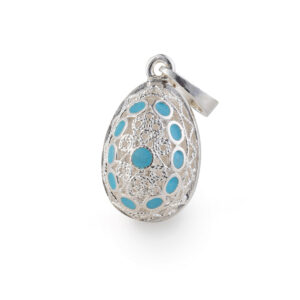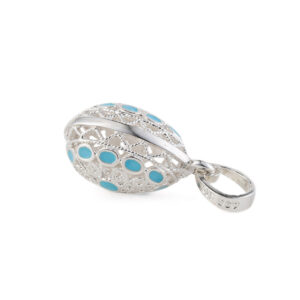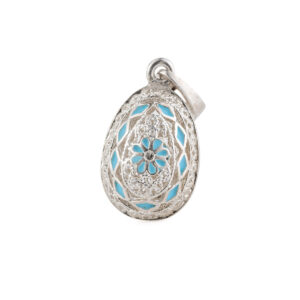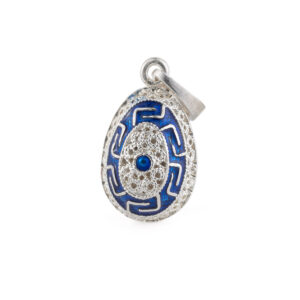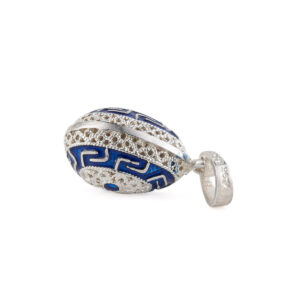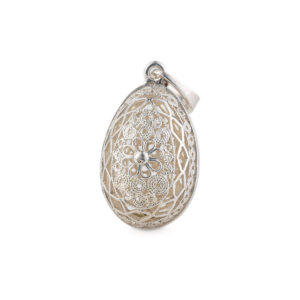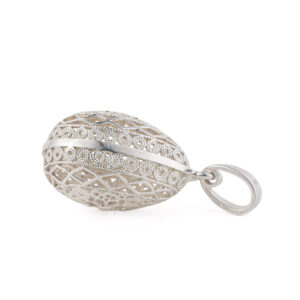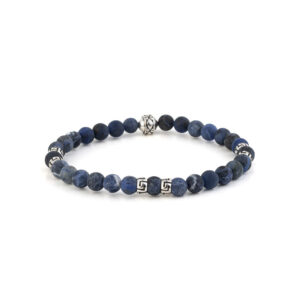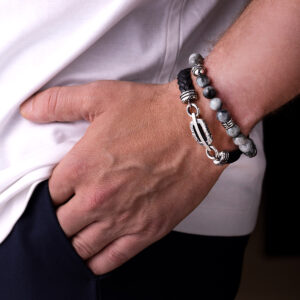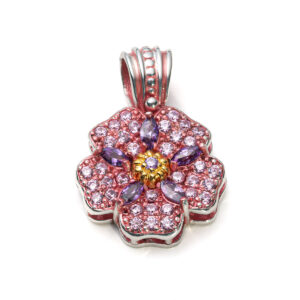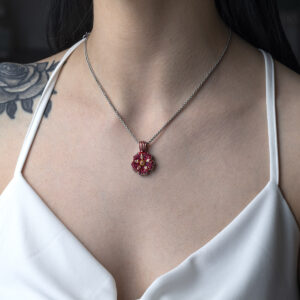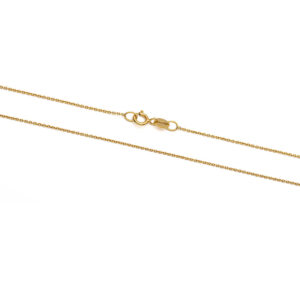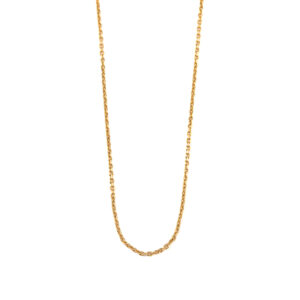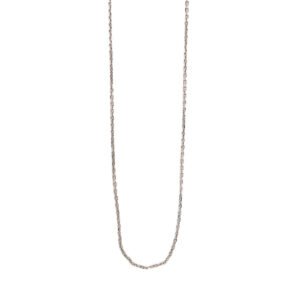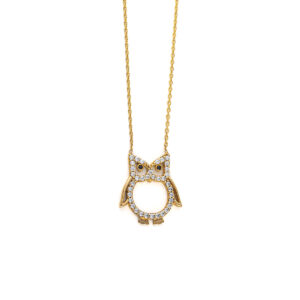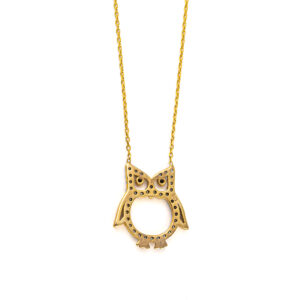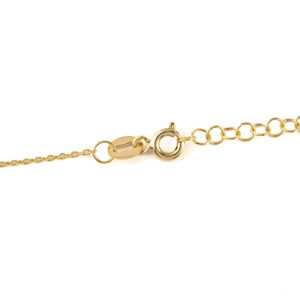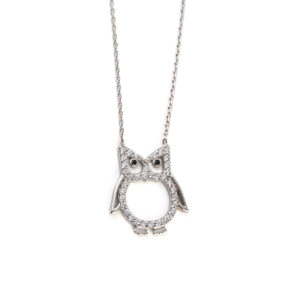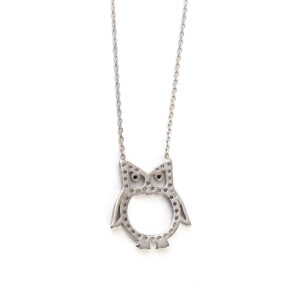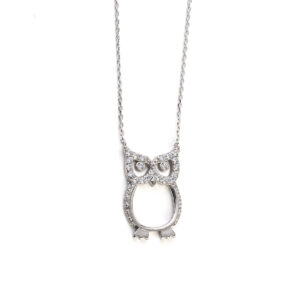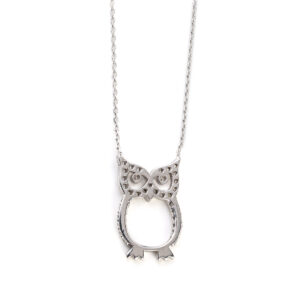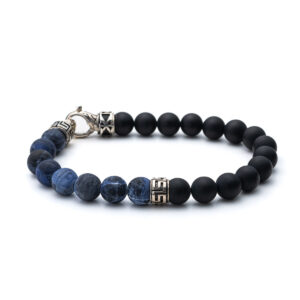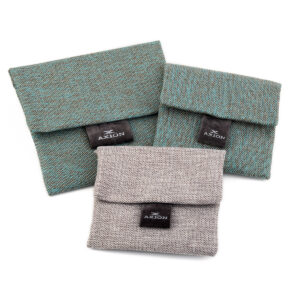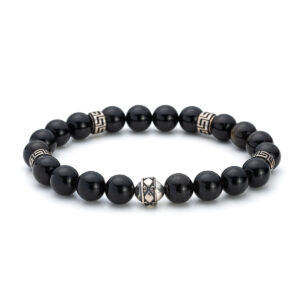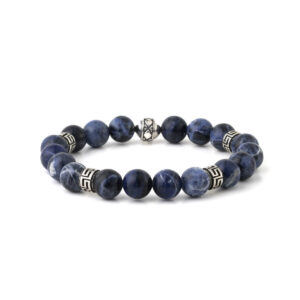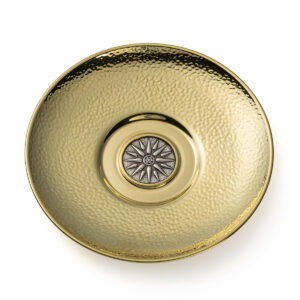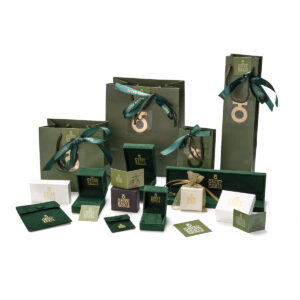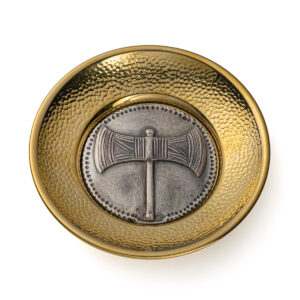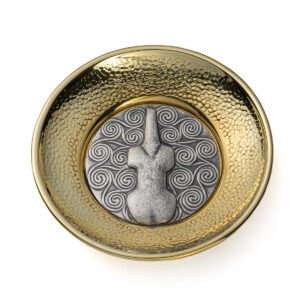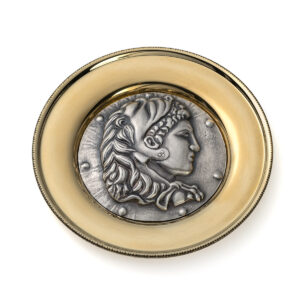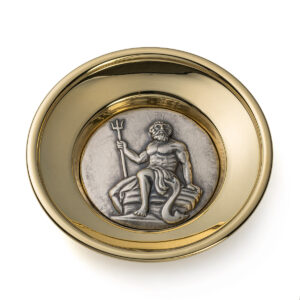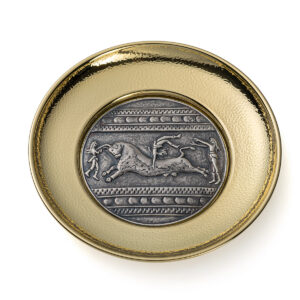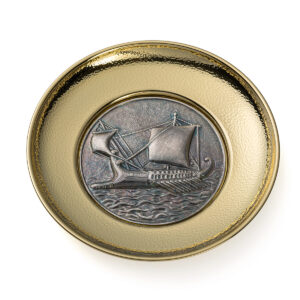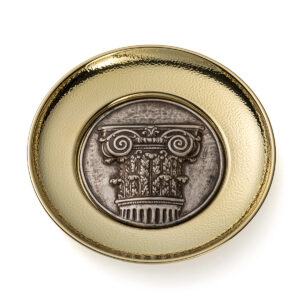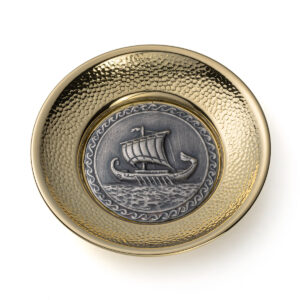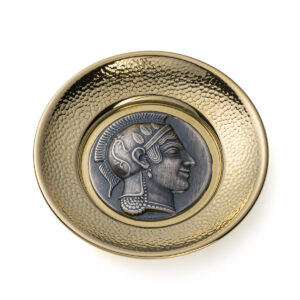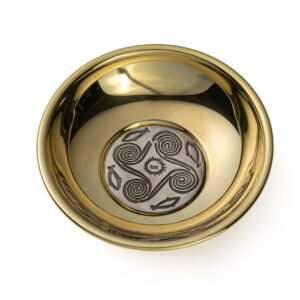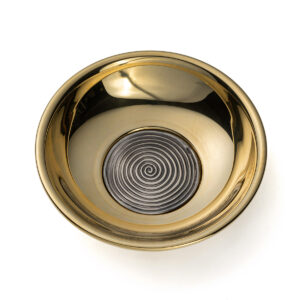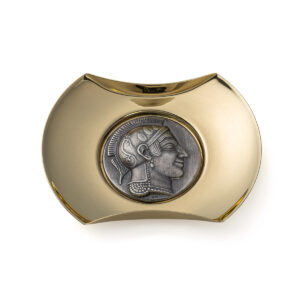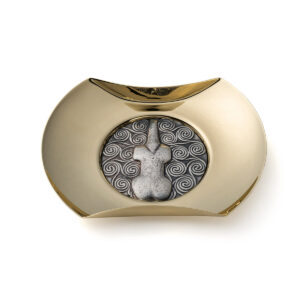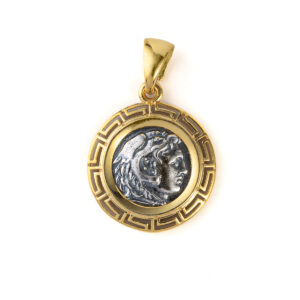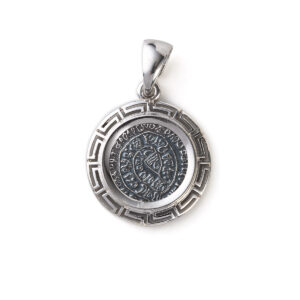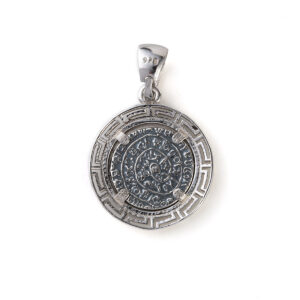Amphora Pendant Necklace with Meander – 925 Sterling Silver
Ancient Greek Amphora Pendant with enamel and Meander design.
Design inspired by the ancient Greek history.
Made of sterling silver.
Handmade item.
The chain shown is included.
Amphora is a Greco – Roman word developed in ancient Greek during the Bronze Age. An amphora is a type of container of a characteristic shape and size. Amphorae were used for the transport and storage of various products, both liquid and dry, but mostly for wine. They are most often ceramic. the amphorae used in Ancient Greek vase painting. (source wikipedia)
Meander or Meandros design, one of the most historic symbols of the Greek World, also called Greek Key and symbolizes long life and eternity. The pattern with Meander was used in antiquity to decorate the frieze of temples.
Amphora Pendant Necklace with Meander – 925 Sterling Silver and Gold Plated
Ancient Greek Amphora Pendant with enamel and Meander design.
Design inspired by the ancient Greek history.
Made of sterling silver and gold plated.
Handmade item.
The chain shown is included.
Amphora is a Greco – Roman word developed in ancient Greek during the Bronze Age. An amphora is a type of container of a characteristic shape and size. Amphorae were used for the transport and storage of various products, both liquid and dry, but mostly for wine. They are most often ceramic. the amphorae used in Ancient Greek vase painting. (source wikipedia)
Meander or Meandros design, one of the most historic symbols of the Greek World, also called Greek Key and symbolizes long life and eternity. The pattern with Meander was used in antiquity to decorate the frieze of temples.
Bouzouki Pendant Necklace – 925 Sterling Silver
Greek Bouzouki Charm with enamel. The pendant is decorated with rosette motifs.
Made of sterling silver.
Handmade in Greece.
The chain shown is included.
Design inspired by the Greek tradition.
Explore Heritage Collection
History
The Greek bouzouki is a plucked musical instrument of the lute family, called the thabouras or tambouras family. The tambouras existed in ancient Greece as the pandura, and can be found in various sizes and shapes. The bouzouki and the baglamas are the direct descendants. The bouzouki arrived in Greece following the 1919–1922 war in Asia Minor and the subsequent population exchange between Greece and Turkey. The early bouzoukia mostly had three courses. At the end of the 1950s, four-course (tetrachordo) bouzoukia started to gain popularity. The four-course bouzouki was made popular by Manolis Chiotis. Manolis Chiotis was a Greek rebetiko and laiko composer, singer, and bouzouki player. He is considered one of the greatest bouzouki soloists of all time.
Greek Bouzouki Pendant Necklace
Greek Bouzouki Charm pendant decorated with rosette motifs.
Made of sterling silver and gold plated.
Handmade in Greece.
The chain shown is included.
Design inspired by the Greek tradition.
Explore Heritage Collection
History
The Greek bouzouki is a plucked musical instrument of the lute family, called the thabouras or tambouras family. The tambouras existed in ancient Greece as the pandura, and can be found in various sizes and shapes. The bouzouki and the baglamas are the direct descendants. The bouzouki arrived in Greece following the 1919–1922 war in Asia Minor and the subsequent population exchange between Greece and Turkey. The early bouzoukia mostly had three courses. At the end of the 1950s, four-course (tetrachordo) bouzoukia started to gain popularity. The four-course bouzouki was made popular by Manolis Chiotis. Manolis Chiotis was a Greek rebetiko and laiko composer, singer, and bouzouki player. He is considered one of the greatest bouzouki soloists of all time.
Greek Tsarouhi Pendant Necklace with Enamel – 925 Sterling Silver and Gold Plated
Have you witnessed the changing of the guards in Syntagma square? This is the most traditional shoe of Greece (tsarouhi). The pendant is decorated with green enamel and rosette motif.
Made of sterling silver and gold plated.
Handmade item.
Design inspired by the Greek tradition
The chain shown is included.
The rosette (rose) is a timeless jewel, symbol and amulet. The origin of the term is the Greek word for rose – rodon (ρόδον). Its use began in the Mycenaean era and continues as far as the 2nd millennia BC. The Mycenaean Rosette is a motif that was widespread throughout Mesopotamia, Egypt, Greece and other ancient civilizations. Rosette or Rodax was probably the most popular and favorite decorative element in Mycenaean era, classical antiquity and Byzantine times.
Amphora Pendant Necklace with Enamel – 925 Sterling Silver and Gold Plated
Ancient Greek Amphora Pendant with enamel.
Design inspired by the ancient Greek history.
Made of sterling silver and gold plated.
Handmade item
Amphora is a Greco – Roman word developed in ancient Greek during the Bronze Age. An amphora is a type of container of a characteristic shape and size. Amphorae were used for the transport and storage of various products, both liquid and dry, but mostly for wine. They are most often ceramic. the amphorae used in Ancient Greek vase painting. (source wikipedia)
Rosette Flower Egg Pendant Necklace with Enamel
The pendant is embellished with a fine filigree and enamel in Faberge style.
Made of 925 sterling silver and gold plated.
Handmade in Greece.
The chain shown is included.
Filigree is a delicate kind of jewellery metalwork, made with tiny beads or twisted threads, or both in combination, soldered together or to the surface of an object of the same metal and arranged in artistic motifs. The art of filigree dates back to ancient history. The first of the found jewelry in this technique have been found in Mesopotamia and dates to thousands of years BC. In the ancient world and particularly in Asia Minor, this art grew were at the highest level.
Fabergé egg is a jeweled egg created by the House of Fabergé, in St. Petersburg, Imperial Russia. Virtually all were manufactured under the supervision of Peter Carl Fabergé between 1885 and 1917,[citation needed] the most famous being the 50 “Imperial” eggs, 43 of which survive, made for the Russian Tsars Alexander III and Nicholas II as Easter gifts for their wives and mothers. The first Fabergé egg was crafted for Tsar Alexander III, who had decided to give his wife, the Empress Maria Feodorovna, an Easter egg in 1885. Peter Carl Fabergé was a Russian jeweller best known for the famous Fabergé eggs made in the style of genuine Easter eggs, using precious metals and gemstones. He’s the founder of the famous jewelry legacy House of Fabergé.
Cross Egg Silver Pendant Necklace with Enamel
The pendant is embellished with a fine filigree and enamel in Faberge style.
Made of 925 sterling silver and gold plated.
Handmade in Greece.
The chain shown is included.
Filigree is a delicate kind of jewellery metalwork, made with tiny beads or twisted threads, or both in combination, soldered together or to the surface of an object of the same metal and arranged in artistic motifs. The art of filigree dates back to ancient history. The first of the found jewelry in this technique have been found in Mesopotamia and dates to thousands of years BC. In the ancient world and particularly in Asia Minor, this art grew were at the highest level.
Fabergé egg is a jeweled egg created by the House of Fabergé, in St. Petersburg, Imperial Russia. Virtually all were manufactured under the supervision of Peter Carl Fabergé between 1885 and 1917,[citation needed] the most famous being the 50 “Imperial” eggs, 43 of which survive, made for the Russian Tsars Alexander III and Nicholas II as Easter gifts for their wives and mothers. The first Fabergé egg was crafted for Tsar Alexander III, who had decided to give his wife, the Empress Maria Feodorovna, an Easter egg in 1885. Peter Carl Fabergé was a Russian jeweller best known for the famous Fabergé eggs made in the style of genuine Easter eggs, using precious metals and gemstones. He’s the founder of the famous jewelry legacy House of Fabergé.
Greek Key Egg Pendant Necklace in 925 Sterling Silver
The pendant is embellished with a fine filigree and enamel in Faberge style.
Made of 925 sterling silver and gold plated.
Handmade in Greece.
The chain shown is included.
Filigree is a delicate kind of jewellery metalwork, made with tiny beads or twisted threads, or both in combination, soldered together or to the surface of an object of the same metal and arranged in artistic motifs. The art of filigree dates back to ancient history. The first of the found jewelry in this technique have been found in Mesopotamia and dates to thousands of years BC. In the ancient world and particularly in Asia Minor, this art grew were at the highest level.
Fabergé egg is a jeweled egg created by the House of Fabergé, in St. Petersburg, Imperial Russia. Virtually all were manufactured under the supervision of Peter Carl Fabergé between 1885 and 1917,[citation needed] the most famous being the 50 “Imperial” eggs, 43 of which survive, made for the Russian Tsars Alexander III and Nicholas II as Easter gifts for their wives and mothers. The first Fabergé egg was crafted for Tsar Alexander III, who had decided to give his wife, the Empress Maria Feodorovna, an Easter egg in 1885. Peter Carl Fabergé was a Russian jeweller best known for the famous Fabergé eggs made in the style of genuine Easter eggs, using precious metals and gemstones. He’s the founder of the famous jewelry legacy House of Fabergé.
Flowers Egg Pendant Necklace – 925 Sterling Silver
The pendant is embellished with a fine filigree and enamel in Faberge style.
Made of 925 sterling silver.
Handmade in Greece.
The chain shown is included.
Filigree is a delicate kind of jewellery metalwork, made with tiny beads or twisted threads, or both in combination, soldered together or to the surface of an object of the same metal and arranged in artistic motifs. The art of filigree dates back to ancient history. The first of the found jewelry in this technique have been found in Mesopotamia and dates to thousands of years BC. In the ancient world and particularly in Asia Minor, this art grew were at the highest level.
Fabergé egg is a jeweled egg created by the House of Fabergé, in St. Petersburg, Imperial Russia. Virtually all were manufactured under the supervision of Peter Carl Fabergé between 1885 and 1917,[citation needed] the most famous being the 50 “Imperial” eggs, 43 of which survive, made for the Russian Tsars Alexander III and Nicholas II as Easter gifts for their wives and mothers. The first Fabergé egg was crafted for Tsar Alexander III, who had decided to give his wife, the Empress Maria Feodorovna, an Easter egg in 1885. Peter Carl Fabergé was a Russian jeweller best known for the famous Fabergé eggs made in the style of genuine Easter eggs, using precious metals and gemstones. He’s the founder of the famous jewelry legacy House of Fabergé.
Filigree Egg Pendant Necklace with Spiral Motifs – 925 Sterling Silver
The pendant is embellished with a fine filigree and enamel in Faberge style.
Made of 925 sterling silver.
Handmade in Greece.
The chain shown is included.
Filigree is a delicate kind of jewellery metalwork, made with tiny beads or twisted threads, or both in combination, soldered together or to the surface of an object of the same metal and arranged in artistic motifs. The art of filigree dates back to ancient history. The first of the found jewelry in this technique have been found in Mesopotamia and dates to thousands of years BC. In the ancient world and particularly in Asia Minor, this art grew were at the highest level.
Fabergé egg is a jeweled egg created by the House of Fabergé, in St. Petersburg, Imperial Russia. Virtually all were manufactured under the supervision of Peter Carl Fabergé between 1885 and 1917,[citation needed] the most famous being the 50 “Imperial” eggs, 43 of which survive, made for the Russian Tsars Alexander III and Nicholas II as Easter gifts for their wives and mothers. The first Fabergé egg was crafted for Tsar Alexander III, who had decided to give his wife, the Empress Maria Feodorovna, an Easter egg in 1885. Peter Carl Fabergé was a Russian jeweller best known for the famous Fabergé eggs made in the style of genuine Easter eggs, using precious metals and gemstones. He’s the founder of the famous jewelry legacy House of Fabergé.
Cross Egg Pendant Necklace – 925 Sterling Silver and Green Enamel
The pendant is embellished with a fine filigree and enamel in Faberge style.
Made of 925 sterling silver.
Handmade in Greece.
The chain shown is included.
Filigree is a delicate kind of jewellery metalwork, made with tiny beads or twisted threads, or both in combination, soldered together or to the surface of an object of the same metal and arranged in artistic motifs. The art of filigree dates back to ancient history. The first of the found jewelry in this technique have been found in Mesopotamia and dates to thousands of years BC. In the ancient world and particularly in Asia Minor, this art grew were at the highest level.
Fabergé egg is a jeweled egg created by the House of Fabergé, in St. Petersburg, Imperial Russia. Virtually all were manufactured under the supervision of Peter Carl Fabergé between 1885 and 1917,[citation needed] the most famous being the 50 “Imperial” eggs, 43 of which survive, made for the Russian Tsars Alexander III and Nicholas II as Easter gifts for their wives and mothers. The first Fabergé egg was crafted for Tsar Alexander III, who had decided to give his wife, the Empress Maria Feodorovna, an Easter egg in 1885. Peter Carl Fabergé was a Russian jeweller best known for the famous Fabergé eggs made in the style of genuine Easter eggs, using precious metals and gemstones. He’s the founder of the famous jewelry legacy House of Fabergé.
Filigree Flower Egg Pendant Necklace – Sterling Silver and Enamel
The pendant is embellished with a fine filigree and enamel in Faberge style.
Made of 925 sterling silver.
Handmade in Greece.
The chain shown is included.
Filigree is a delicate kind of jewellery metalwork, made with tiny beads or twisted threads, or both in combination, soldered together or to the surface of an object of the same metal and arranged in artistic motifs. The art of filigree dates back to ancient history. The first of the found jewelry in this technique have been found in Mesopotamia and dates to thousands of years BC. In the ancient world and particularly in Asia Minor, this art grew were at the highest level.
Fabergé egg is a jeweled egg created by the House of Fabergé, in St. Petersburg, Imperial Russia. Virtually all were manufactured under the supervision of Peter Carl Fabergé between 1885 and 1917,[citation needed] the most famous being the 50 “Imperial” eggs, 43 of which survive, made for the Russian Tsars Alexander III and Nicholas II as Easter gifts for their wives and mothers. The first Fabergé egg was crafted for Tsar Alexander III, who had decided to give his wife, the Empress Maria Feodorovna, an Easter egg in 1885. Peter Carl Fabergé was a Russian jeweller best known for the famous Fabergé eggs made in the style of genuine Easter eggs, using precious metals and gemstones. He’s the founder of the famous jewelry legacy House of Fabergé.
Greek Key Egg Enamel Pendant Necklace – 925 Sterling Silver
The pendant is embellished with a fine filigree and enamel in Faberge style.
Made of 925 sterling silver.
Handmade in Greece.
The chain shown is included.
Filigree is a delicate kind of jewellery metalwork, made with tiny beads or twisted threads, or both in combination, soldered together or to the surface of an object of the same metal and arranged in artistic motifs. The art of filigree dates back to ancient history. The first of the found jewelry in this technique have been found in Mesopotamia and dates to thousands of years BC. In the ancient world and particularly in Asia Minor, this art grew were at the highest level.
Fabergé egg is a jeweled egg created by the House of Fabergé, in St. Petersburg, Imperial Russia. Virtually all were manufactured under the supervision of Peter Carl Fabergé between 1885 and 1917,[citation needed] the most famous being the 50 “Imperial” eggs, 43 of which survive, made for the Russian Tsars Alexander III and Nicholas II as Easter gifts for their wives and mothers. The first Fabergé egg was crafted for Tsar Alexander III, who had decided to give his wife, the Empress Maria Feodorovna, an Easter egg in 1885. Peter Carl Fabergé was a Russian jeweller best known for the famous Fabergé eggs made in the style of genuine Easter eggs, using precious metals and gemstones. He’s the founder of the famous jewelry legacy House of Fabergé.
Filigree Flower Egg Enamel Pendant Necklace – 925 Sterling Silver
The pendant is embellished with a fine filigree and enamel in Faberge style.
Made of 925 sterling silver.
Handmade in Greece.
The chain shown is included.
Filigree is a delicate kind of jewellery metalwork, made with tiny beads or twisted threads, or both in combination, soldered together or to the surface of an object of the same metal and arranged in artistic motifs. The art of filigree dates back to ancient history. The first of the found jewelry in this technique have been found in Mesopotamia and dates to thousands of years BC. In the ancient world and particularly in Asia Minor, this art grew were at the highest level.
Fabergé egg is a jeweled egg created by the House of Fabergé, in St. Petersburg, Imperial Russia. Virtually all were manufactured under the supervision of Peter Carl Fabergé between 1885 and 1917,[citation needed] the most famous being the 50 “Imperial” eggs, 43 of which survive, made for the Russian Tsars Alexander III and Nicholas II as Easter gifts for their wives and mothers. The first Fabergé egg was crafted for Tsar Alexander III, who had decided to give his wife, the Empress Maria Feodorovna, an Easter egg in 1885. Peter Carl Fabergé was a Russian jeweller best known for the famous Fabergé eggs made in the style of genuine Easter eggs, using precious metals and gemstones. He’s the founder of the famous jewelry legacy House of Fabergé.
Meander Bracelet with Sodalite Beads – Sterling Silver
Sterling Silver bracelet with meander motif and sodalite 6mm beads.
This bracelet comes in a beautiful box.
Made in 925⁰ sterling silver.
Handmade in Greece.
Explore Axion Jewelry
Meander Bracelet with Eagle Eye Beads – Sterling Silver
Sterling Silver bracelet with meander motif and ocean jasper beads.
This bracelet comes in a beautiful box.
Made in 925⁰ sterling silver.
Handmade item.
Explore Axion Jewelry
Flower Pendant with Swarovski Crystals
Made of 925 sterling silver.
Handmade item.
The chain shown is our 925 Sterling Silver Chain (not included).
Explore Byzantine Collection
Sterling Silver Cable Chain – Length 50 cm
Made of 925 Sterling Silver.
Handmade item.
Owl Necklace with White Zircon – 925 Sterling Silver and Gold Plated
This necklace is inspired by the Ancient Greek jewels which represent the symbol of the Wisdom Owl.
Made of 925°sterling silver and gold plated
Owl of Athena
In Greek mythology, a little owl traditionally represents or accompanies Athena, the virgin goddess of wisdom. Because of such association, the bird – often referred to as the «owl of Athena» has been used as a symbol of knowledge, wisdom, perspicacity and erudition.
Owl Necklace with White Zircon – 925 Sterling Silver Gold Plated
This necklace is inspired by the Ancient Greek jewels which represent the symbol of the Wisdom Owl.
Made of 925°sterling silver and gold plated
Owl of Athena
In Greek mythology, a little owl traditionally represents or accompanies Athena, the virgin goddess of wisdom. Because of such association, the bird – often referred to as the «owl of Athena» has been used as a symbol of knowledge, wisdom, perspicacity and erudition.
Owl Zircon Necklace – 925 Sterling Silver Gold Plated
This necklace is inspired by the Ancient Greek jewels which represent the symbol of the Wisdom Owl.
Made of 925°sterling silver and gold plated
Owl of Athena
In Greek mythology, a little owl traditionally represents or accompanies Athena, the virgin goddess of wisdom. Because of such association, the bird – often referred to as the «owl of Athena» has been used as a symbol of knowledge, wisdom, perspicacity and erudition.
Owl Zircon Necklace – 925 Sterling Silver
This necklace is inspired by the Ancient Greek jewels which represent the symbol of the Wisdom Owl.
Made of 925°sterling silver.
Owl of Athena
In Greek mythology, a little owl traditionally represents or accompanies Athena, the virgin goddess of wisdom. Because of such association, the bird – often referred to as the «owl of Athena» has been used as a symbol of knowledge, wisdom, perspicacity and erudition.
Owl Necklace with Zircon – 925 Sterling Silver
This necklace is inspired by the Ancient Greek jewels which represent the symbol of the Wisdom Owl.
Made of 925°sterling silver.
Owl of Athena
In Greek mythology, a little owl traditionally represents or accompanies Athena, the virgin goddess of wisdom. Because of such association, the bird – often referred to as the «owl of Athena» has been used as a symbol of knowledge, wisdom, perspicacity and erudition.
Meander Bracelet – 925 Sterling Silver with Sodalite Beads
Sterling Silver bracelet with meander motif and sodalite beads.
This bracelet comes in a beautiful box.
Made in 925⁰ sterling silver.
Handmade item.
Greek Key Bracelet with Gemstone Beads – 925 Sterling Silver
A flexible bracelet inspired by the ancient Meander motif with onyx or sodalite or bloodstones.
Made of 925⁰ sterling silver.
This bracelet comes in a beautiful box.
Handmade item.
Meander design is a decorative border constructed from a continuous line, shaped into a repeated motif. Such a design is also called the Greek fret or Greek key design, although these are modern designations. One the one hand, the name “meander” recalls the twisting and turning path of the Meander River in Asia Minor, and on the other hand, as Karl Kerenyi pointed out, “the meander is the figure of a labyrinth in linear form” the meaning is that these is no beginning and to end end in some cases so it become the symbol of long life and eternity.
Bronze Plate Vergina Sun – 925 Silver
Bronze Decorative plate with representation made of 925 sterling silver, inspired by ancient Greece
Handmade item.
The Vergina Sun also known as the “Star of Vergina” is a rayed solar symbol appearing in ancient Greek art. The Vergina Sun proper has sixteen triangular rays. The name “Vergina Sun” became widely used after the archaeological excavations in and around the small town of Vergina, in northern Greece, during the late 1970s.
Bronze Plate Minoan Axe – 925 Silver
Bronze Decorative plate with representation made of 925 sterling silver, inspired by ancient Greece
Handmade item.
Labrys is, according to Plutarch, Minoan word for the double headed axe called in Greek πέλεκυς (pélekus). In ancient Crete, the double axe was an important sacred symbol of the Minoan religion. In Crete it never accompanies male gods, but always female goddesses. It seems that it associated with the worship of Mother Earth or Great Goddess.
Bronze Plate Cycladic Figurine – 925 Silver
Bronze Decorative plate with representation made of 925 sterling silver, inspired by ancient Greece
Handmade item.
The best known type of artwork that has survived is the marble figurine, most commonly a single full-length female figure with arms folded across the front.
Bronze Plate Alexander the Great
Bronze Decorative plate with representation made of 925 sterling silver, inspired by ancient Greece
Handmade item.
Alexander the Great the King of Macedonia is considered one of the most important forms of world history. Lysimachus was a Macedonian officer and diadochus of Alexander the Great, who became a basileus in 306 BC, ruling Thrace, Asia Minor and Macedon.
Bronze Plate The God of the Sea Poseidon
Bronze Decorative plate with representation made of 925 sterling silver, inspired by ancient Greece
Handmade item.
Poseidon was one of the Twelve Olympians in ancient Greek religion and myth, god of the sea, storms, earthquakes and horses.
Poseidon was protector of seafarers, and of many Hellenic cities and colonies.
Bronze Plate Minoan Civilization Bull-leaping – 925 Silver
Bronze Decorative plate with representation made of 925 sterling silver, inspired by ancient Greece
Handmade item.
Bull-leaping (Ancient Greek: ταυροκαθάψια, taurokathapsia) is a term for various types of non-violent bull fighting. Some are based on an ancient ritual from the Minoan civilization involving an acrobat leaping over the back of a charging bull (or cow).
Bronze Plate Caduceus The Symbol of Medicine – 925 Silver
Bronze Decorative plate with representation made of 925 sterling silver, inspired by ancient Greece
Handmade item.
The caduceus is the traditional symbol of Hermes and features two snakes winding around an often winged staff. It is used as a symbol of medicine.
Bronze Plate with Ancient Ship Trireme
Bronze Decorative plate with representation made of 925 sterling silver, inspired by ancient Greece
Handmade item.
A trireme was an ancient vessel and a type of galley that was used by the ancient maritime civilizations of the Mediterranean Sea, especially the Phoenicians, ancient Greeks and Romans.
Bronze Plate Corinthian Column – 925 Silver
Bronze Decorative plate with representation made of 925 sterling silver, inspired by ancient Greece
Handmade item.
The Corinthian order is named for the Greek city of Corinth, to which it was connected in the period. There are three distinct orders in Ancient Greek architecture: Doric, Ionic, and Corinthian. The Corinthian order is the last developed of the three principal classical orders of ancient Greek and Roman architecture. The Corinthian, with its offshoot the Composite, is the most ornate of the orders. This architectural style is characterized by slender fluted columns and elaborate capitals decorated with acanthus leaves and scrolls. Also there are many variations. The Corinthian Order in 334 BC it appeared as an external feature on the Choragic Monument of Lysicrates in Athens, and then used on a huge scale at the Temple of Zeus Olympia in Athens, (174 BC – AD 132).
Bronze Plate Goddess of Justice Themis – 925 Silver
Bronze Decorative plate with representation made of 925 sterling silver, inspired by ancient Greece
Handmade item.
In Greek mythology, Themis is one of the twelve Titan children of Gaia and Uranus, and the second wife of Zeus. She is the personification of justice, divine order, fairness, law, and custom, and her symbols include the Scales of Justice.
Bronze Plate Wisdom Owl – 925 Silver
Bronze Decorative plate with representation made of 925 sterling silver, inspired by ancient Greece
Handmade item.
Goddess Athena and Owl – Athenian silver tetradrachm
Dracma was the currency used in Greece during several periods in its history. The tetradrachm was an Ancient Greek silver coin equivalent to fourdrachmae in Athens it replaced the earlier “heraldic” type of didrachms and it was in wide circulation from ca. 510 to ca. 38 BC. This coin belongs to the so-called “new style Athenian coins” minted between 166 and 64 B.C. and is considered one of the most popular ancient Greek coins which illustrate the portrait of Goddess Athena on the one side and the wisdom owl on the other. Athena is an ancient Greek goddess associated with wisdom, handicraft, and warfare. Athena was regarded as the patron and protectress of various cities across Greece, particularly the city of Athens, from which she most likely received her name. She’s usually shown in art wearing a helmet and holding a spear. Her major symbols include owls, olive trees, and snakes. Her temples were located atop the fortified Acropolis in the central part of the city. The Parthenon on the Athenian Acropolis is dedicated to her, along with numerous other temples and monuments. Her main festival in Athens was the Panathenaia, which was celebrated in midsummer and was the most important festival on the Athenian calendar. In the classical Olympian pantheon, Athena was regarded as the favorite daughter of Zeus. The owl traditionally accompanies Athena. Because of such association, the owl has been used as a symbol of knowledge and wisdom. The inscriptions contain the city’s “national” appellation (“ΑΘΕ», i.e. “of the Athenians”).
Bronze Plate Ancient Ship Trireme
Bronze Decorative plate with representation made of 925 sterling silver, inspired by ancient Greece
Handmade item.
A trireme was an ancient vessel and a type of galley that was used by the ancient maritime civilizations of the Mediterranean Sea, especially the Phoenicians, ancient Greeks and Romans.
Bronze Plate Goddess Athena – 925 Silver
Bronze Decorative plate with representation made of 925 sterling silver, inspired by ancient Greece
Handmade item.
Goddess Athena – Athenian silver tetradrachm
Dracma was the currency used in Greece during several periods in its history.
The tetradrachm was an Ancient Greek silver coin equivalent to fourdrachmae in Athens it replaced the earlier “heraldic” type of didrachms and it was in wide circulation from ca. 510 to ca. 38 BC.
The front side of this coin is decorated with Goddess Athena. Athena is an ancient Greek goddess associated with wisdom, handicraft, and warfare.
Athena was regarded as the patron and protectress of various cities across Greece, particularly the city of Athens, from which she most likely received her name. She’s usually shown in art wearing a helmet and holding a spear. Her major symbols include owls, olive trees, and snakes. Her temples were located atop the fortified Acropolis in the central part of the city. The Parthenon on the Athenian Acropolis is dedicated to her, along with numerous other temples and monuments. Her main festival in Athens was the Panathenaia, which was celebrated in midsummer and was the most important festival on the Athenian calendar.
In the classical Olympian pantheon, Athena was regarded as the favorite daughter of Zeus.
Bronze Ancient Greek Plate Cycladic Art – 925 Silver
Bronze Decorative plate with representation made of 925 sterling silver, inspired by ancient Greece
Handmade item.
Bronze Ancient Greek Plate with Spiral Symbol – 925 Silver
Bronze Decorative plate with representation made of 925 sterling silver, inspired by ancient Greece
Handmade item.
The spiral is one of the oldest symbols of human spirituality, carved or painted into rocks from thousands of years ago. Symbol of movement and progressive development, growth, expansion, cosmic energy, symbol of the sun..Spirals have been foun in burial sites, uin vases, in jewelry, clothing, weapons… They can be seen in every aspect in nature, like the tides in the oceans, the winds, the plants, the shells. The spiral phenomenon has been explained thought mathematics from the time of Archimedes, the great Greek mathematician
Bronze Plate Athenian Tetradrachm Wisdom Owl – 925 Silver
Bronze Decorative plate with representation made of 925 sterling silver, inspired by ancient Greece
Handmade item.
Goddess Athena and Owl – Athenian silver tetradrachm
Dracma was the currency used in Greece during several periods in its history. The tetradrachm was an Ancient Greek silver coin equivalent to fourdrachmae in Athens it replaced the earlier “heraldic” type of didrachms and it was in wide circulation from ca. 510 to ca. 38 BC. This coin belongs to the so-called “new style Athenian coins” minted between 166 and 64 B.C. and is considered one of the most popular ancient Greek coins which illustrate the portrait of Goddess Athena on the one side and the wisdom owl on the other. Athena is an ancient Greek goddess associated with wisdom, handicraft, and warfare. Athena was regarded as the patron and protectress of various cities across Greece, particularly the city of Athens, from which she most likely received her name. She’s usually shown in art wearing a helmet and holding a spear. Her major symbols include owls, olive trees, and snakes. Her temples were located atop the fortified Acropolis in the central part of the city. The Parthenon on the Athenian Acropolis is dedicated to her, along with numerous other temples and monuments. Her main festival in Athens was the Panathenaia, which was celebrated in midsummer and was the most important festival on the Athenian calendar. In the classical Olympian pantheon, Athena was regarded as the favorite daughter of Zeus. The owl traditionally accompanies Athena. Because of such association, the owl has been used as a symbol of knowledge and wisdom. The inscriptions contain the city’s “national” appellation (“ΑΘΕ», i.e. “of the Athenians”).
Bronze Plate with Goddess Athena – 925 Silver
Bronze Decorative plate with representation made of 925 sterling silver, inspired by ancient Greece
Handmade item.
Goddess Athena – Athenian silver tetradrachm
Dracma was the currency used in Greece during several periods in its history.
The tetradrachm was an Ancient Greek silver coin equivalent to fourdrachmae in Athens it replaced the earlier “heraldic” type of didrachms and it was in wide circulation from ca. 510 to ca. 38 BC.
The front side of this coin is decorated with Goddess Athena. Athena is an ancient Greek goddess associated with wisdom, handicraft, and warfare.
Athena was regarded as the patron and protectress of various cities across Greece, particularly the city of Athens, from which she most likely received her name. She’s usually shown in art wearing a helmet and holding a spear. Her major symbols include owls, olive trees, and snakes. Her temples were located atop the fortified Acropolis in the central part of the city. The Parthenon on the Athenian Acropolis is dedicated to her, along with numerous other temples and monuments. Her main festival in Athens was the Panathenaia, which was celebrated in midsummer and was the most important festival on the Athenian calendar.
In the classical Olympian pantheon, Athena was regarded as the favorite daughter of Zeus.
Bronze Plate with Cycladic Figurine – 925 Silver
Bronze Decorative plate with representation made of 925 sterling silver, inspired by ancient Greece
Handmade item.
The best-known art of this period are the marble figures usually called “idols” or “figurines”These marble figures are seen scattered around the Aegean.
Ancient Ship Trireme Bronze Plate
Bronze Decorative plate with representation made of 925 sterling silver, inspired by ancient Greece
Handmade item.
A trireme was an ancient vessel and a type of galley that was used by the ancient maritime civilizations of the Mediterranean Sea, especially the Phoenicians, ancient Greeks and Romans.
Hercules Pendant with Meander Bezel – 925 Sterling Silver Gold Plated
Handmade pendant inspired by the ancient Greek tetradrachm coin, depicting Hercules.
Made of 925⁰ sterling silver and gold plated.
Minoan Phaistos Disc Pendant with Meander Bezel – 925 Sterling Silver
A pendant inspired by the Ancient Minoan Greek Phaistos disc, decorated with a meander bezel.
Made of 925⁰ sterling silver.
Handmade item.
The Phaistos Disc is a disk of fired clay from the Minoan palace of Phaistos on the island of Crete. Now, the island of Crete is part of modern Greece. The disc was discovered in 1908 by the Italian archaeologist Luigi Pernier in the Minoan palace-site of Phaistos. While it is not clear that it is a script, most attempted decipherments assume it is; most additionally assume a syllabary, others an alphabet or logography or a calendar.
